Are you pining for elegant vines with sumptuous flowers, lively colors, and a carefree habit, but live in a region with short summers?
Look no further than the reliable charm of clematis. If you have long, cold winters and want to make the most of a short growing season, these vigorous climbers provide an easy way to add color and texture to your garden.
Growing clematis successfully in cold regions, such as USDA Hardiness Zones 3-4, starts with picking the right plant – not all can handle sub-zero temperatures.
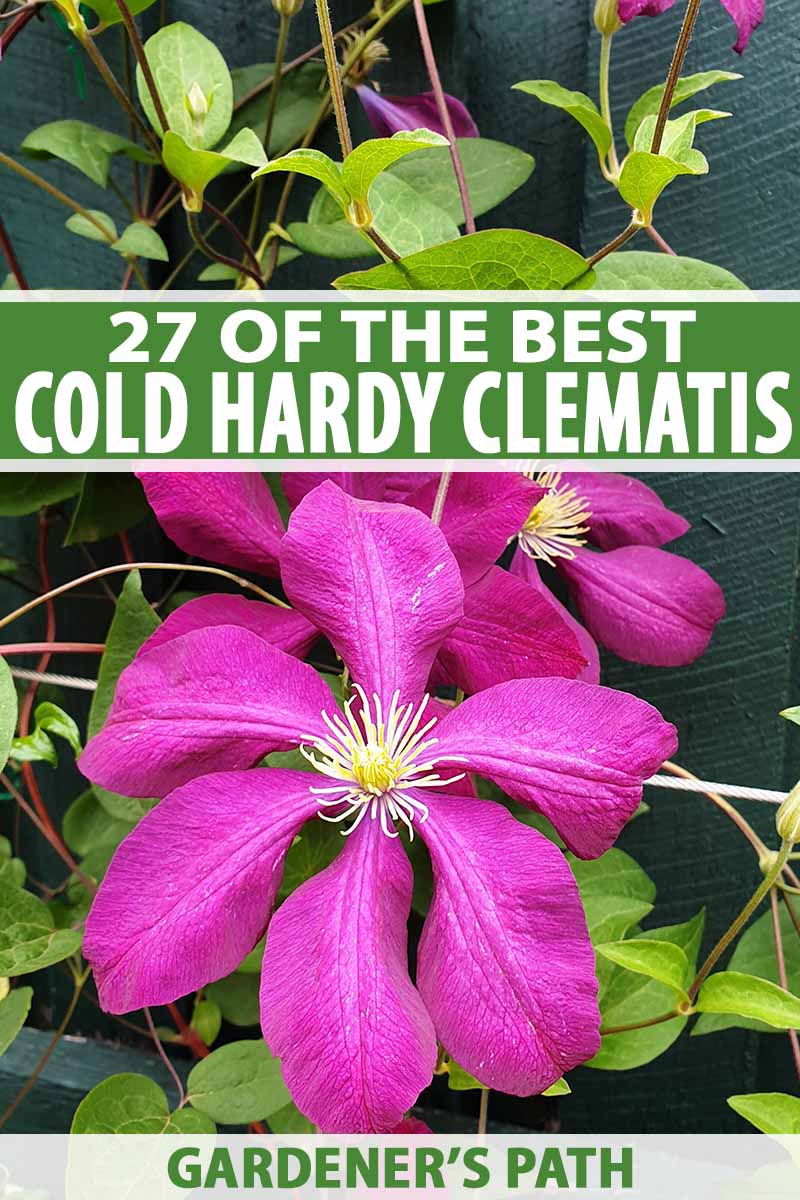
We link to vendors to help you find relevant products. If you buy from one of our links, we may earn a commission.
Fortunately, there are several species and cultivars that are hardy enough to survive – and thrive – in these areas.
So, if your short summers and long, cold winters make growing perennial vines a challenge, read on for our list of clematis top picks for Zones 3 and 4 – the best cold-hardy varieties for tough winters!
Clematis Varieties for Zone 3 and Zone 4
Cold Hardy Cultivars
Although most clematis varieties are unsuitable for the rigors of Zone 3 and Zone 4 winters, luckily there are cold hardy species and cultivars to be found in all three clematis groups.
Before purchasing any perennial, always be sure to check the zone rating to ensure that it can survive in your region.
For your convenience, here’s our collection of some of our favorite, most reliable performers for extreme cold hardiness:
Group 1
Group 1 provides a good selection of clematis suited to temperatures down to Zone 3.
A subdivision known as the Atragene group features small-flowered, early blooming varieties that are extremely hardy, undemanding, and among the easiest to grow. As an added bonus, you don’t have to prune them, which makes for light cleanup at the end of winter!
The Atragene group includes the species Clematis alpina, C. koreana, and C. macropetala and their hybrids.
Native to mountainous regions, these plants produce small to medium, nodding flowers in bell or lantern shapes that come in shades of blue, mauve, pink, purple, red, white, and yellow.
Many develop handsome, swirling seed heads in shades of blond and silver that add cheerful, late season interest.
1. Pamela Jackman
A vigorous climber, ‘Pamela Jackman’ forms masses of bell-shaped, deep blue to purple flowers with striking white stamens in mid- to late spring.

Lime green leaves add a handsome contrast, and ornamental silvery seed heads form in summer. Hardy in USDA Hardiness Zones 4-9, this pretty cultivar grows 9 to 12 feet and looks sumptuous sprawling over arbors, fences, and pergolas.
2. Jacqueline Du Pre
‘Jacqueline du Pre’ blooms in late spring with small pink to mauve skirted flowers edged in pale pink, with dark veining and a white stamen.

Leaves are bright green and elegant, and silvery seed heads form in summer, adding late season texture to the garden. A medium climber, mature growth reaches is 6 to 8 feet tall and it is well-suited to arches, containers, fences, and pergolas. Hardy in Zones 3-9.
3. Constance
‘Constance’ is wonderfully free-flowering and drips with nodding, bell-shaped blooms from mid- to late spring. Dusty pink flowers have semi-double petals that reveal buttery yellow stamens.

After flowering, showy silver seed heads add a charming touch well into fall. Hardy in Zones 3-9, ‘Constance’ grows 6 to 8 feet tall, and makes a spectacular display against an arbor, trellis, or wall.
4. Bluebird
‘Bluebird’ delights with a heavy display of nodding, single or semi-double flowers in lavender-blue with cream-to-lime-green stamens.
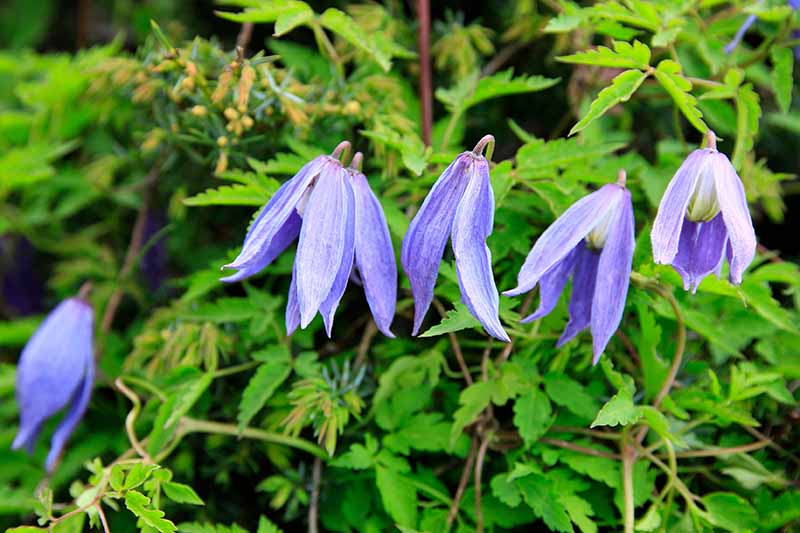
This cultivar flowers heavily in spring, with the occasional second flush in midsummer followed by wispy, silver seed heads.
A vigorous grower with a mature height of 8 to 10 feet, it excels in extreme cold temperatures – with a frigid Zone 2-9 hardiness. This is a good choice for light shade gardens.
5. Maidwell Hall
‘Maidwell Hall’ is renowned for its profuse display of frilly, semi-double flowers in lavender-blue with chartreuse stamens.
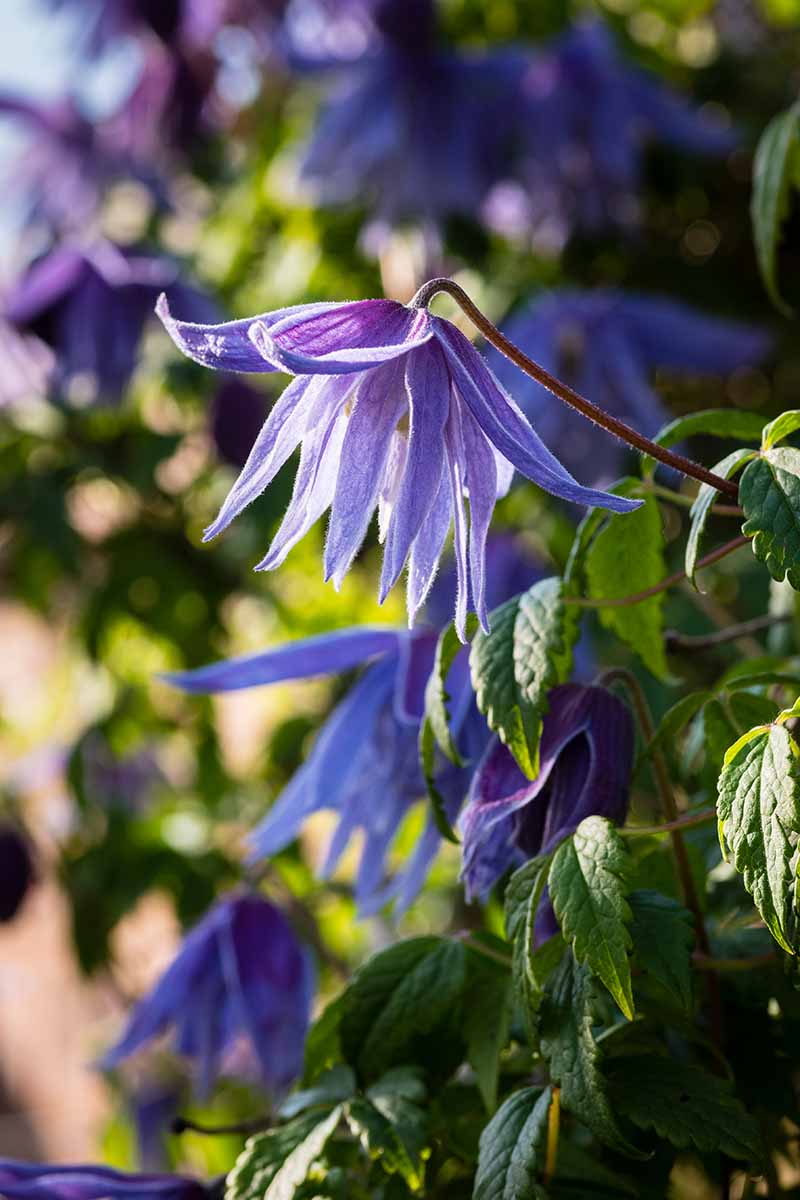
This cultivar continues to flower lightly throughout the summer, and decorative seed heads adorn vines in late summer.
Compact growth is 6 to 8 feet tall and it is ideal for growing up and over fences, rock piles, or stumps, and scrambling through small shrubs and trees. Hardy in Zones 3-9.
6. Rosy O’Grady
‘Rosy O’Grady’ features narrow petals of rose pink with dark veining and wavy edges, and a skirt of light pink staminodes encircle the pale yellow stamens.

Bloom time is in late spring, and showy seed heads follow in summer.
At maturity it reaches 9 to 12 feet tall, with a twining and trailing growth habit that adds easy appeal to arbors and containers, or as a ground cover plant. Hardy in Zones 3-9.
7. White Swan
‘White Swan’ puts on a reliable display of dainty, bell-shaped flowers from late spring to early summer.
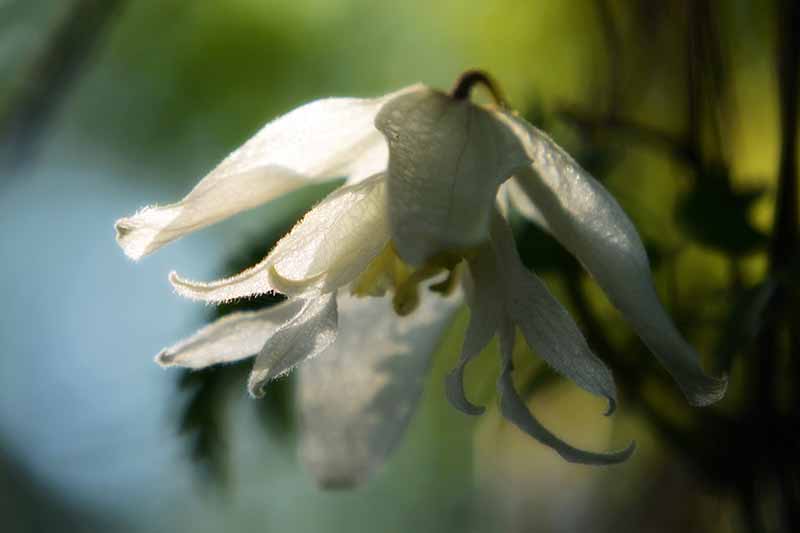
Semi-double petals of pure white and with buttery yellow stamens stand out against the foliage, and wooly seed heads add late season interest.
Hardy in Zones 3-9, this versatile climber reaches 10 to 12 feet tall and can be grown in containers, as a ground cover, or scrambling up any vertical support.
Group 2
Group 2 varieties bloom vigorously in spring, and often provide a second, lighter flush of flowers throughout the summer.
The two sets of flowers grow on old and new wood respectively.
These need a light pruning in early spring to clean up dead wood and remove any untidy stems, and another light to medium pruning in summer to remove spent flower heads and encourage bud set on the new growth.
They can underperform somewhat in very cold zones because they need warm temperatures early in the year for two sets of flowers to form.
In colder regions, they often produce only one full flush of flowers starting in early summer.
Flowers face up or outward and are available in two-tone bicolor cultivars and single colors of blue, mauve, pink, purple, red, white, and yellow.
A few of my favorite cultivars include:
8. Multi Blue
‘Multi Blue’ features an abundance of dramatic double flowers in shades of deep blue to purple with pale center bars.
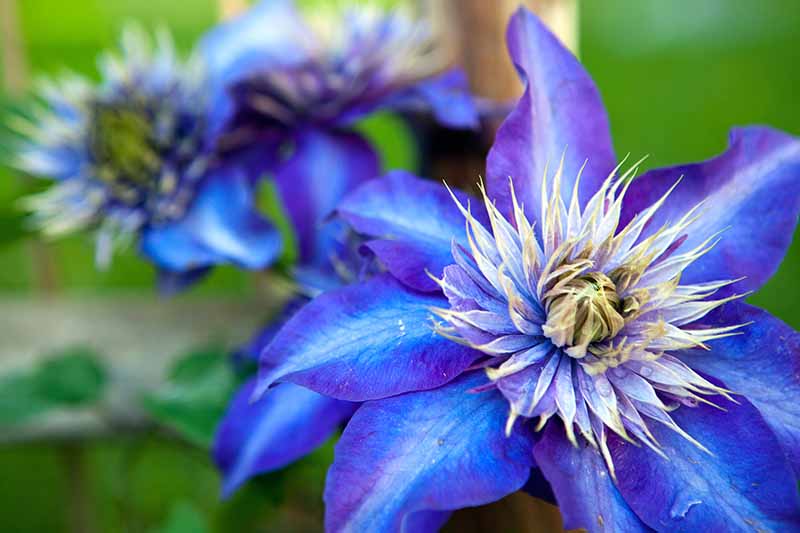
Silvery blue staminodes form a striking pincushion on the recurve petals, and they bloom in late spring.
A compact variety, mature plants reach 6 to 8 feet tall and flowers measure up to 5 inches across.
‘Multi Blue’ appreciates some light afternoon shade in locations with hot summers and is ideal for containers, small gardens, or climbing on a vertical support. Hardy in Zones 4-11.
‘Multi Blue’ plants in one-gallon containers are available from Burpee.
9. Bees’ Jubilee
A showy cultivar, ‘Bees’ Jubilee’ boasts stunning two-tone flowers of creamy pink with a deep cherry stripe, and creamy yellow filaments topped with rosy anthers.
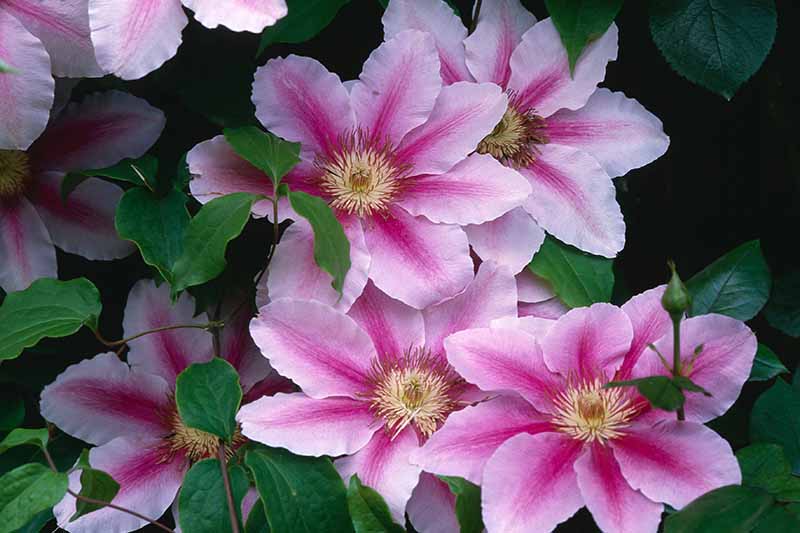
The large blooms measure 6 to 8 inches across and are followed by silky seed heads.
Fast growing, its mature height is 6 to 13 feet, and it blooms in late spring and again in late summer. Abundantly free flowering, it’s an impressive scrambler to use as a ground cover or to add vertical interest on arbors, trellises, and climbing through small trees or shrubs. Hardy in Zones 4-11.
10. Blue Ravine
‘Blue Ravine’ produces full, cornflower to lilac blooms, with violet center bars and rosy pink anthers.
The large 6- to 8-inch flowers have a delightful fragrance. They bloom in late spring through early summer, and again in late summer.
‘Blue Ravine’ grows up to 8 feet tall with a 24-inch spread, and a twining habit makes it useful as an accent plant in a container, on a trellis, or anywhere it can grow up and through shrubs and hedges.
‘Blue Ravine’ plants can be purchased at Burpee.
11. Capitaine Thuilleaux
‘Capitaine Thuilleaux’ has showy, two-tone flowers of pale pink with rich, strawberry center bars and wavy petal edges.

Dark magenta-tipped stamens add a distinctive focal point to the 7-inch, lightly scented flowers.
A compact plant, maximum growth at maturity is 6 to 9 feet. This cultivar is very floriferous in mid-spring, with a lighter flush in midsummer, and a pleasing display of seed heads in late summer. ‘Capitaine Thuilleaux’ is an ideal choice for containers and cottage or courtyard gardens, and it also grows well in partial shade. Hardy in Zones 4-11.
12. Duchess of Edinburgh
The ‘Duchess of Edinburgh’ cultivar is known for its luminous, fully-double flowers of white to blush pink with creamy yellow anthers.
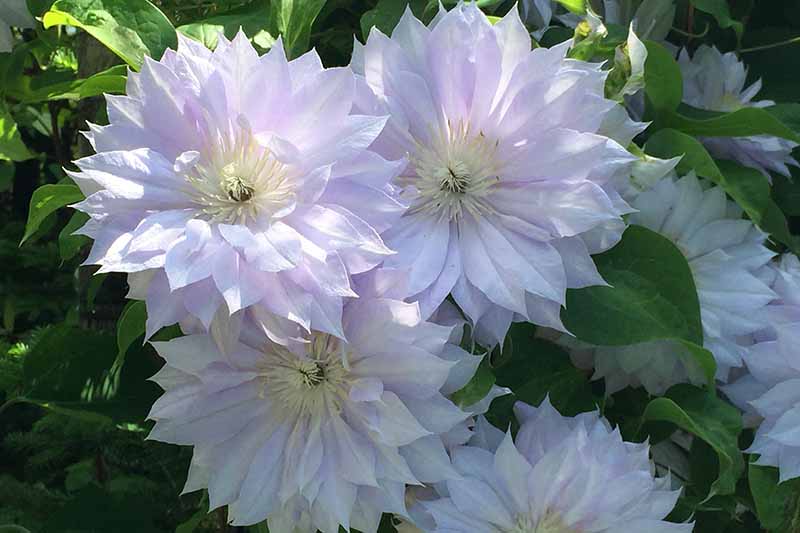
The 4- to 6-inch flowers form a striking rosette and bloom in late spring, then again in late summer.
The ‘Duchess of Edinburgh’ grows 6 to 8 feet tall and is moderately vigorous in growth. It makes an attractive display in containers, and on arbors, fences, or any vertical support. Hardy in Zones 4-11.
13. Fireworks
With a profusion of eye-catching, bi-colored flowers, ‘Fireworks’ is a showstopper.

The ruffled lilac petals have vivid cerise central bars and white filaments topped with magenta anthers. The showy flowers grow 7 to 8 inches in diameter, and bloom in late spring with a lighter flowering in late summer.
Growth is semi-woody, and plants reach 8 to 12 feet in height with a spread of 3 to 6 feet. ‘Fireworks’ adds dramatic color to upright structures, or twining its way through shrubs and small trees. Hardy in Zones 4-8.
14. Henryi
Profusely free-flowering, ‘Henryi’ has ivory, rounded flowers with pale mauve edges.
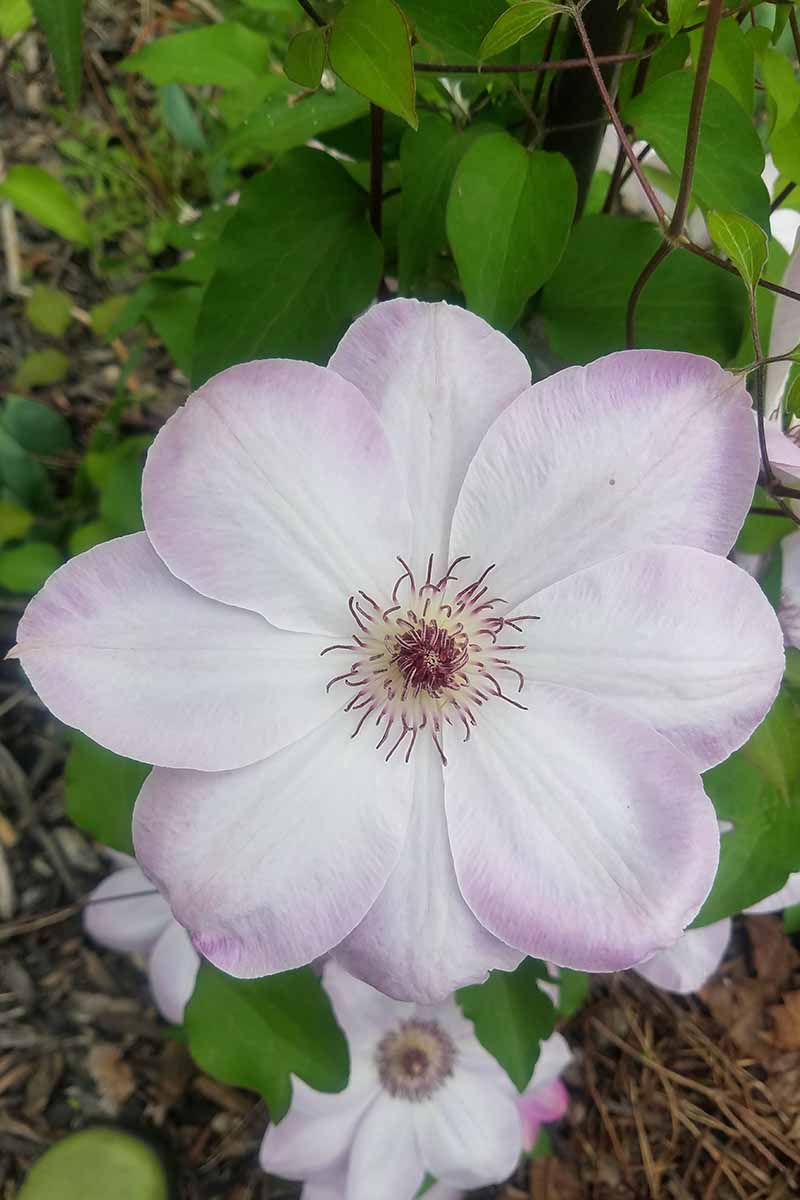
Lime green central bars fade as blooms mature, and purple anthers add a delicate contrast. The single or semi-double blooms measure 6 to 8 inches across and appear in early summer, with occasional secondary flowers.
A vigorous grower up to 10 to 12 feet tall, it makes a lovely specimen espaliered on arbors, trellises, and pergolas, or it may be used to add summer interest amongst shrubs like rhododendrons. Hardy in Zones 4-11.
15. Moonlight
‘Moonlight’ features full, symmetrical, cream-colored flowers that fade to pearly white with pale yellow stamens.
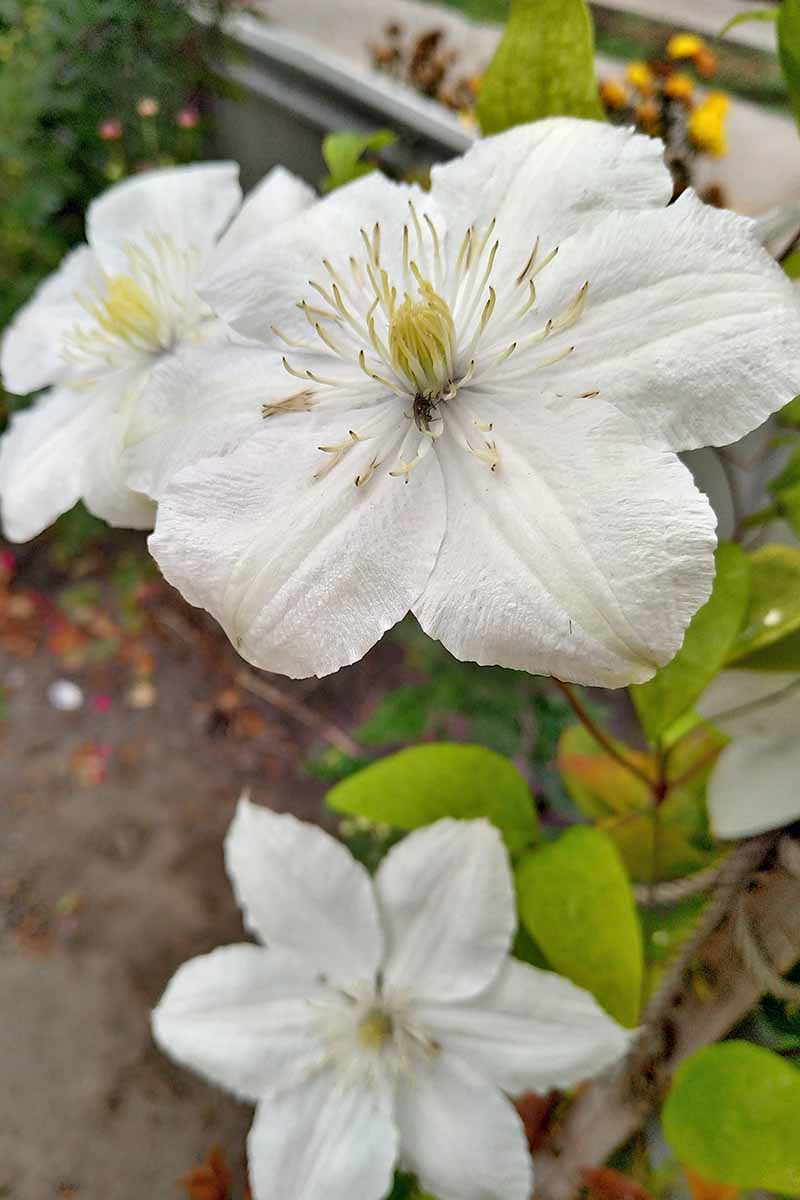
The highly fragrant, single flowers measure 5 to 7 inches. They bloom in late spring and again in late summer.
Hardy in Zones 4-9, this type grows 8 to 10 feet and prefers a partial sun or dappled shade location. This is a sweet choice for patio containers or for climbing up trellises close to windows or paths where the scent can be enjoyed.
16. Nelly Moser
‘Nelly Moser’ is famous for its profuse display of bicolor, starburst flowers measuring 6 to 8 inches across.
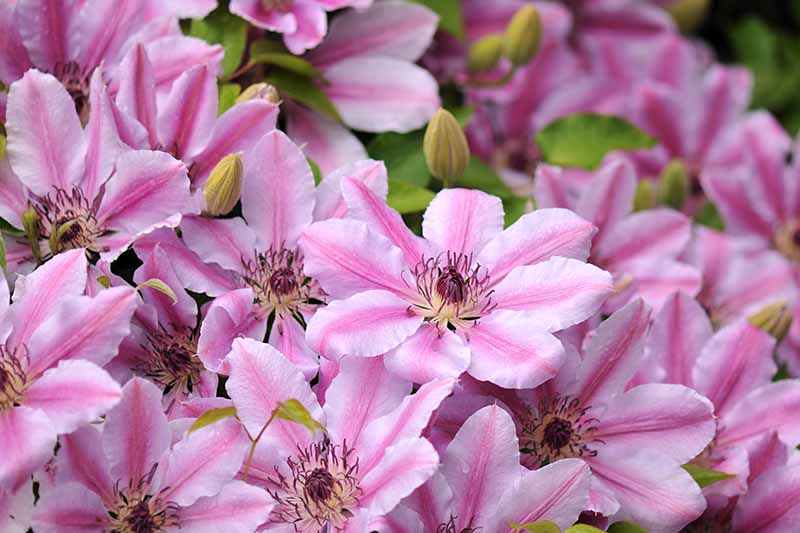
Petals have white or pale pink ruffled edges with cerise center bars, and creamy filaments are topped with rosy anthers. Ornamental wooly seed heads form in summer.
Expect blooms in late spring, with a lighter flush in midsummer.
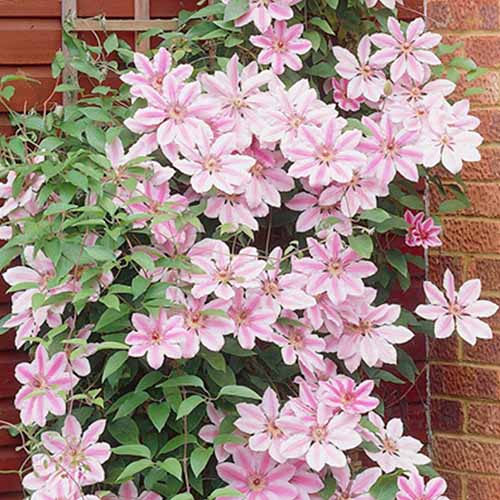
This variety grows 8 to 10 feet and makes a gorgeous specimen plant climbing on arbors, trellises, or lamp posts. Hardy in Zones 4-9.
‘Nelly Moser’ plants are available at Home Depot.
17. Ivan Olsson
‘Ivan Olsson’ features stately flowers in pale mauve and white, with pink filaments and purple anthers.
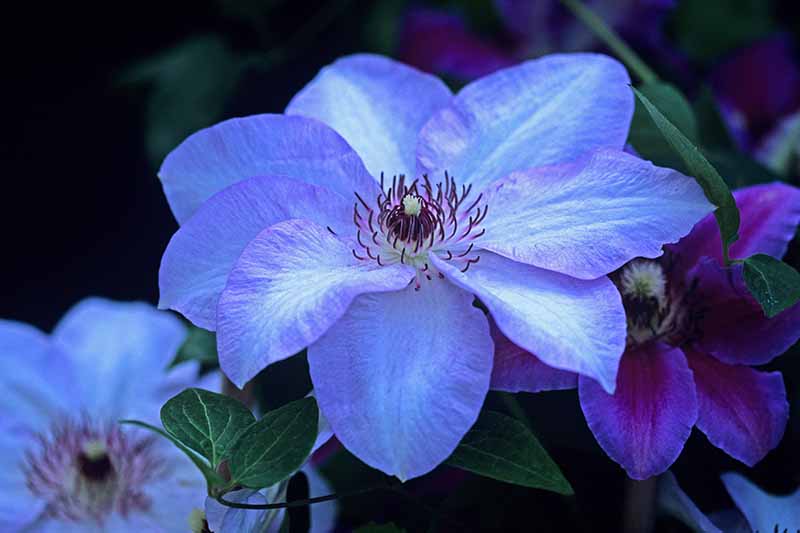
Flowering in late spring with occasional blossoms throughout the summer, the full flowers grow up to 5 to 6 inches. Hardy in Zones 4-9, it grows 7 to 9 feet tall and is ideal in containers, on vertical supports, or as a ground cover or spiller.
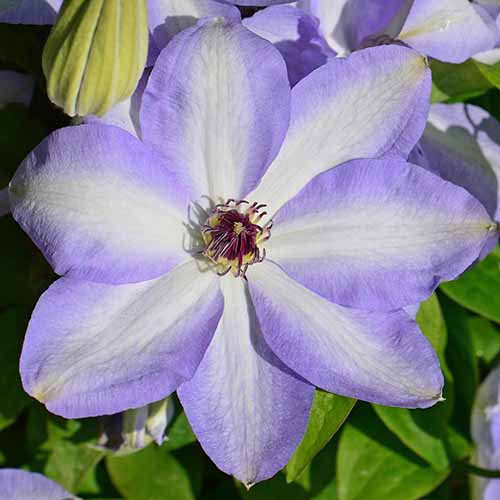
Pick up 4-inch pots of ‘Ivan Olsson’ plants at Home Depot.
Group 3
Group 3 plants are the latest to bloom, and produce a single flush of flowers with a long season – from early or midsummer to early autumn.
The easiest to prune, Group 3 vines need a single, hard pruning in late winter. Stems are cut back to 1 to 2 feet, so stem damage from cold temperatures is never a problem, and flowers form exclusively on new growth.
Group 3 includes many of the showiest varieties, with extra-large flowers that come in an array of dazzling colors. A selection of options with smaller flowers are available in this group as well.
Recommended large-flowered cultivars in Group 3 include:
18. Comtesse de Bouchaud
‘Comtesse de Bouchaud’ features masses of pretty 4- to 6-inch flowers of shell pink to light mauve.
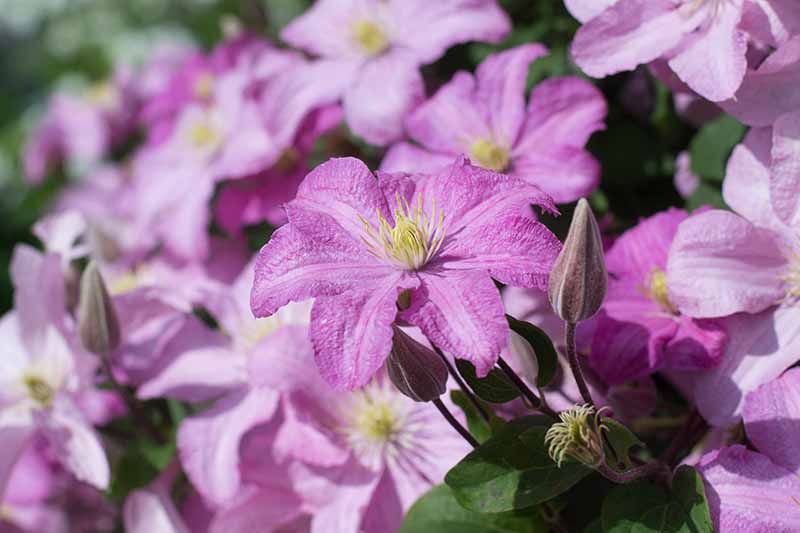
Flowers have butter yellow stamens, and recurve petals give a soft, rounded appearance.
A long bloom time puts on a gorgeous display starting in early summer. Hardy in Zones 4-9, this type grows 6 to 10 feet and performs well in containers, as a climber or ground cover, or in small spaces like courtyard gardens.
19. Ernest Markham
‘Ernest Markham’ makes a memorable impression with stunning magenta or red flowers, cream filaments, and buttery yellow anthers.

Wonderfully free flowering, the generous 4- to 6-inch flowers bloom from midsummer to early fall. Growing 10 to 12 feet tall, it makes a handsome climbing specimen for city, cottage, or courtyard gardens. Hardy in Zones 4-11.
You can find ‘Ernest Markham’ plants at Nature Hills Nursery.
20. Etoile Violette
‘Etoile Violette’ is a long-time favorite for its clusters of deep purple, recurved flowers with blond stamens.
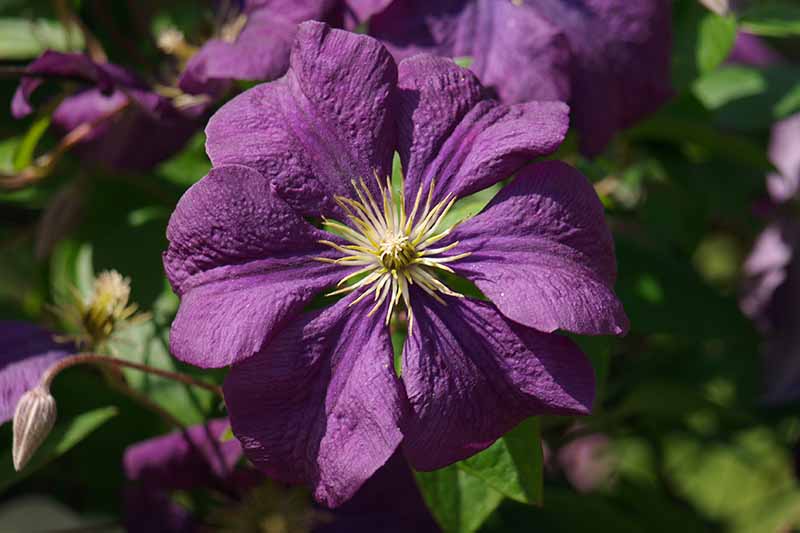
The 4-inch blooms put on a sensational display from mid- to late summer.
Hardy in Zones 4-11, this vigorous climber quickly reaches 10 to 15 feet in height.
It’s a rewarding choice to train on arbors, fences, or walls, or it may be grown as a ground cover.
You can buy 4-inch pots of ‘Estelle Violette’ online from Home Depot.
21. Viola
‘Viola’ features large, violet petals that open to reveal royal purple, velvety blooms.
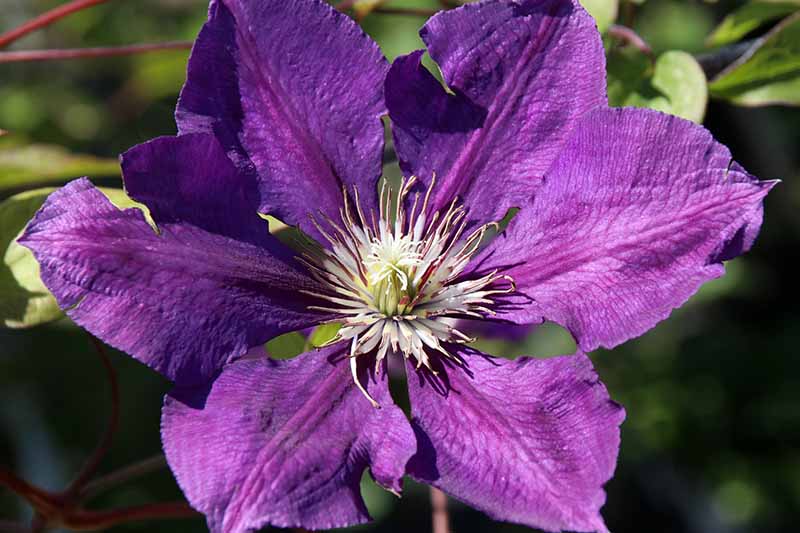
Greenish-white filaments with yellow anthers add striking contrast to the 4- to 6-inch flowers that bloom from midsummer to fall.
Fast growing, it reaches 10 to 12 feet tall and is hardy in Zones 4-9. Train on vertical supports to add late summer color amongst other climbers, like roses.
22. Rouge Cardinal
‘Rouge Cardinal’ features large, showy flowers of cardinal red with gold filaments and mahogany anthers.
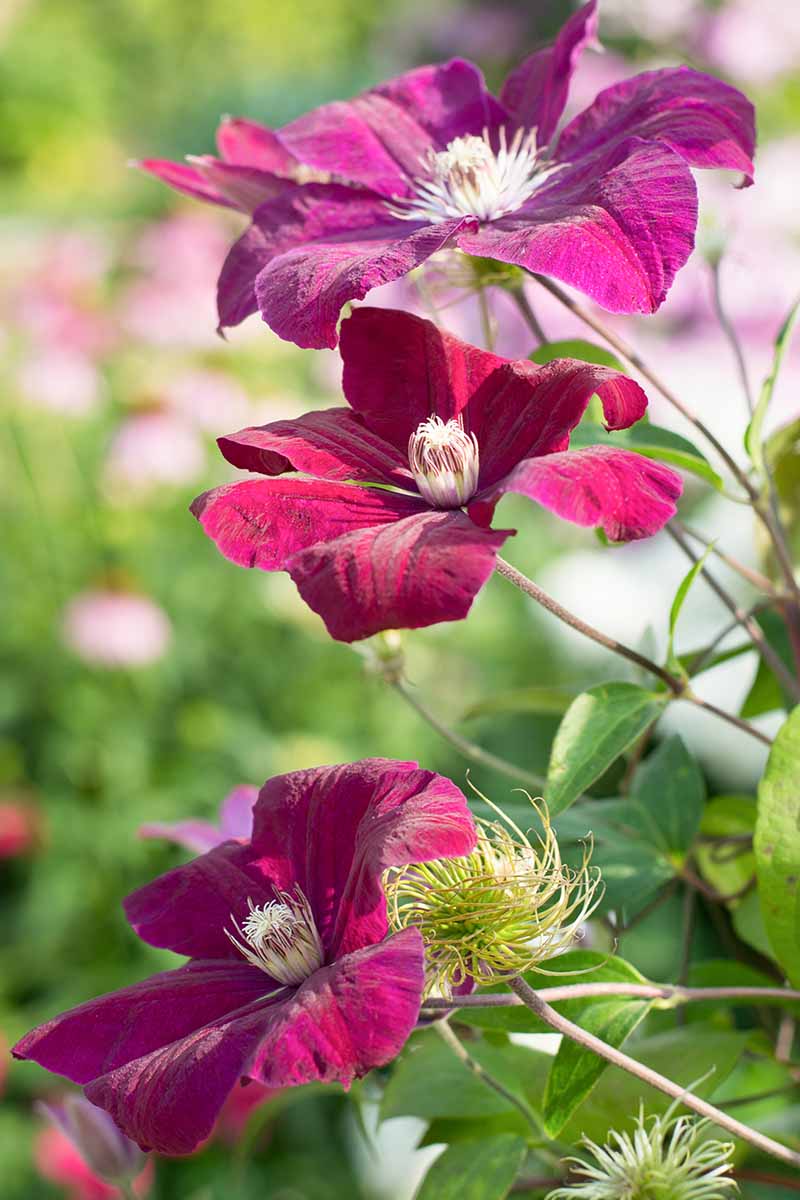
Recurved petal tips give a rounded appearance to the 4- to 6-inch blooms.
Hardy in Zones 3-8, this semi-woody climber grows up to 10 feet and produces a copious display of flowers from early summer to fall. Spectacular in containers, as a spiller, on vertical supports, or growing through small deciduous trees and shrubs.
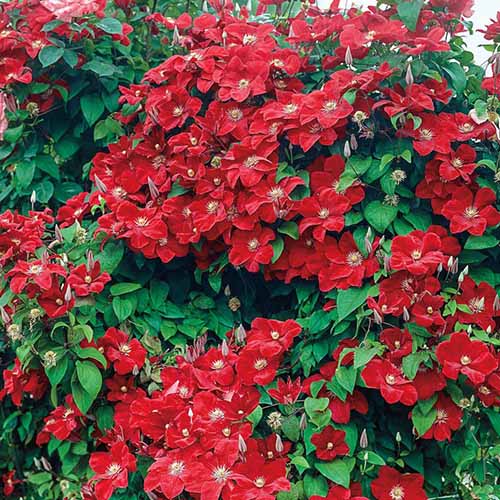
Pick up 4-inch pots of ‘Rouge Cardinal’ from Home Depot.
Small-flowered varieties in Group 3 suitable for cold zones include:
23. Duchess of Albany
The ‘Duchess of Albany’ has charming, tulip-shaped buds in coral pink.
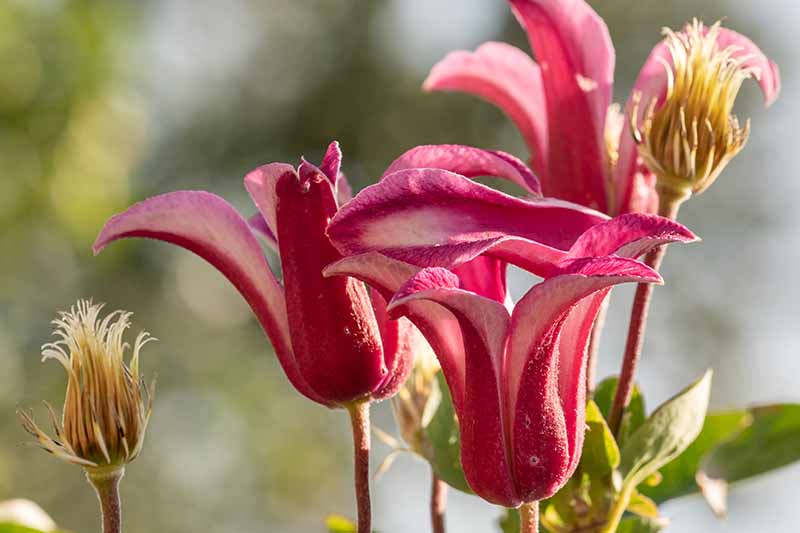
The small, 2- to 3-inch flowers recurve as they mature, revealing deep pink bands on the inner petals and buttery stamens.
Mature growth is typically up to 8 to 12 feet with abundant, steady coverage from midsummer to autumn. A great choice for a ground cover, climbing on trellises and pergolas, or spilling from containers. Hardy in Zones 4-8.
24. Gravetye Beauty
‘Gravetye Beauty’ is known for its distinctive, narrow petals in rich ruby red that open into a delicate starburst.
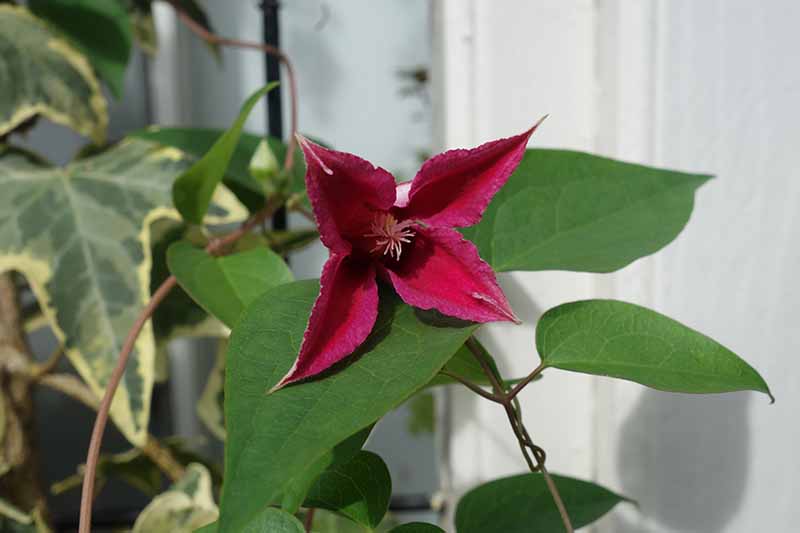
Inner petals are crimson with pale pink edges, cream filaments, and mulberry anthers.
Hardy in Zones 4-8, flowers measure 2 to 3 inches with a mature plant height of 8 to 12 feet. A profuse bloomer from mid- to late summer, it’s well suited to container growing, as a ground cover or spiller, scrambling through deciduous trees and shrubs, or on arches, fences, and walls.
25. Kermesina
‘Kermesina’ features 2-inch, rich magenta flowers with white bases and recurved tips, which give a rounded appearance.
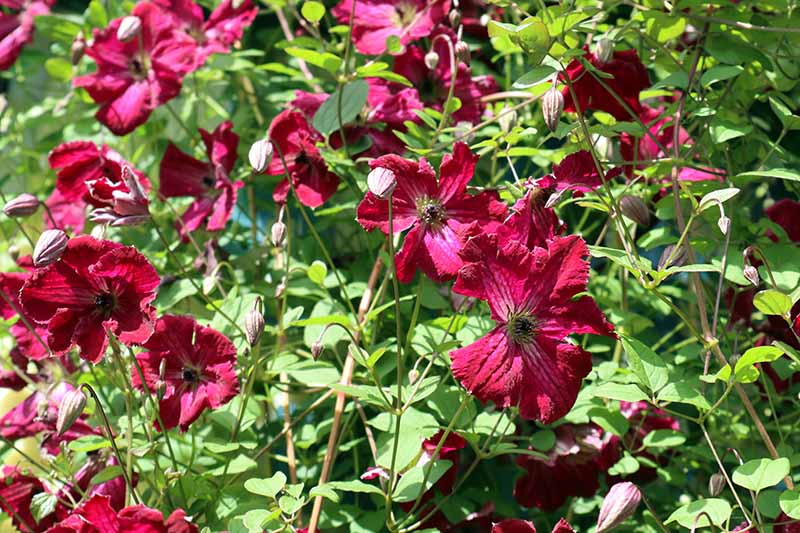
Petals can have a light center bar, and blond filaments have deep wine-colored anthers.
This vigorous climber reaches 8 to 12 feet and puts on a steady show from midsummer to early autumn. Ideal for climbing up an obelisk or trellis, and clambering through shrubs and trees. Hardy in Zones 4-8.
26. Margo Koster
‘Margo Koster’ is very popular for its long season of irregular, coral pink flowers with paler center bars and buttery yellow stamens.
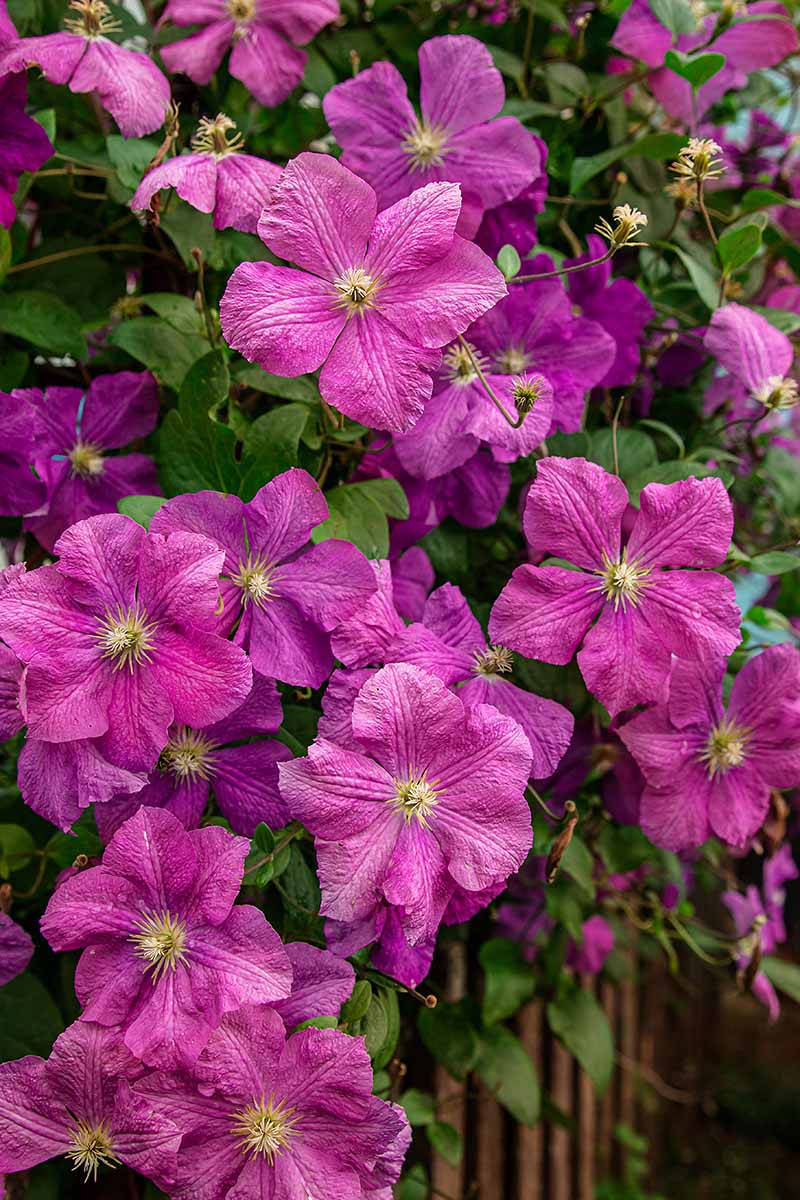
The 3-inch flowers are small but plentiful, and bloom from late spring to fall.
Hardy in Zones 3-9, it grows 10 to 12 feet high and is well suited for vertical growth in cottage or courtyard gardens, or sprawling as a ground cover.
27. Purpurea Plena Elegans
‘Purpurea Plena Elegans’ has distinctive, fluffy double flowers of dusty pink with pale pink, pom-pom staminodes.
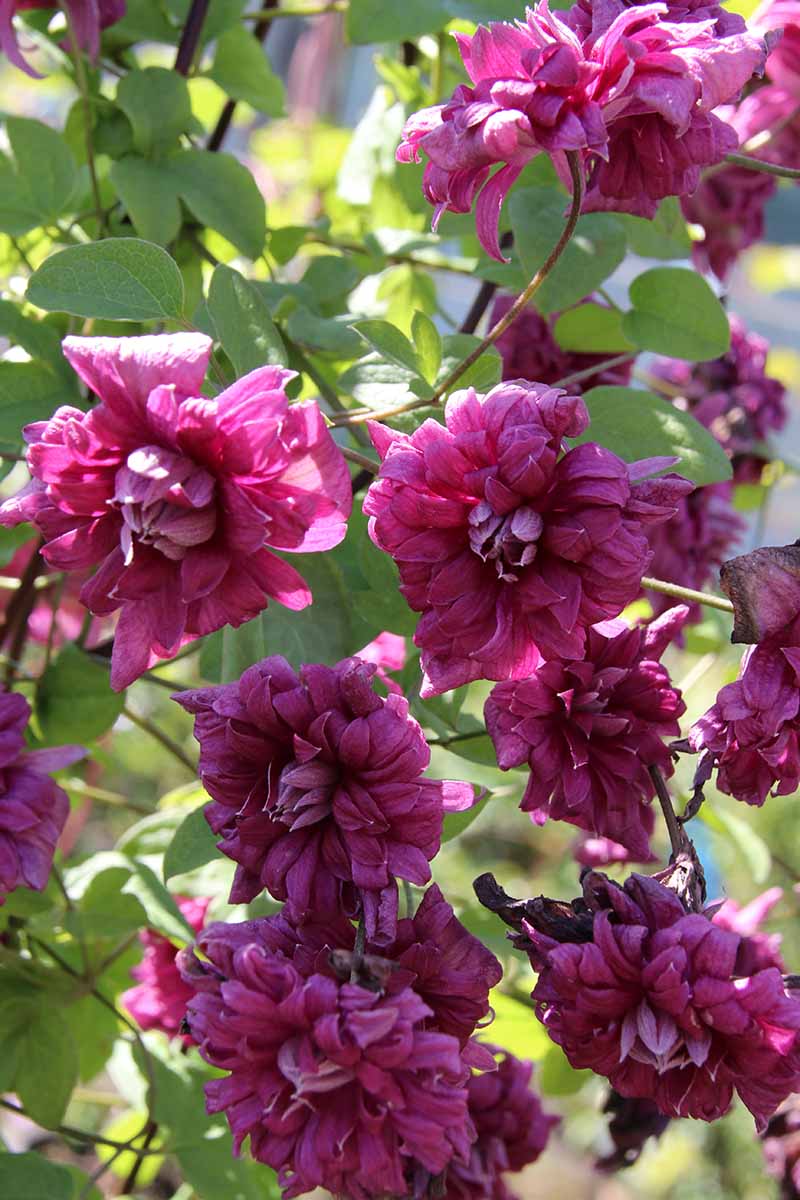
The elegant flowers measure 2 to 3 inches with a long bloom season from midsummer to fall.
Growing 10 to 13 feet tall, the sumptuous display is well suited for climbing, containers, or as a ground cover. Hardy in Zones 4-11.
The Big Chill
Now that you know about the perfect varieties of clematis for Zone 3 and Zone 4, will you plant some of these cold hardy specimens in your garden?
Beautiful, tough, and easy to care for, they’re the perfect solution for gardens that struggle with perennials in sub-zero temperatures!
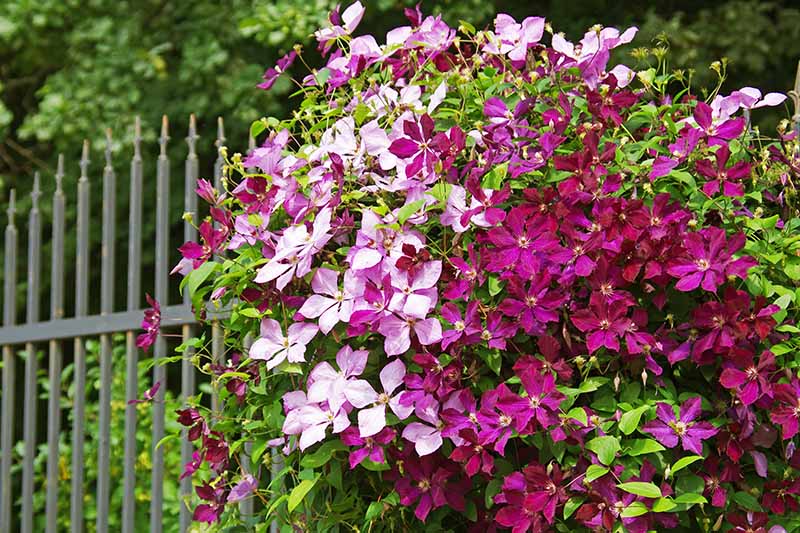
If you folks have any questions or your own favorites to recommend for frigid winters, drop us a note in the comments below.
And be sure to check our other clematis guides to get the most from these remarkable, reliable vines.
- The Complete Clematis Growing Guide
- Types of Clematis and How to Identify Your Vines
- Guide to Clematis Winter Care
© Ask the Experts, LLC. ALL RIGHTS RESERVED. See our TOS for more details. Product photos via Burpee, Home Depot, Nature Hills Nursery, and Spring Hills Nursery. Uncredited photos: Shutterstock. Additional writing and editing by Clare Groom and Allison Sidhu.
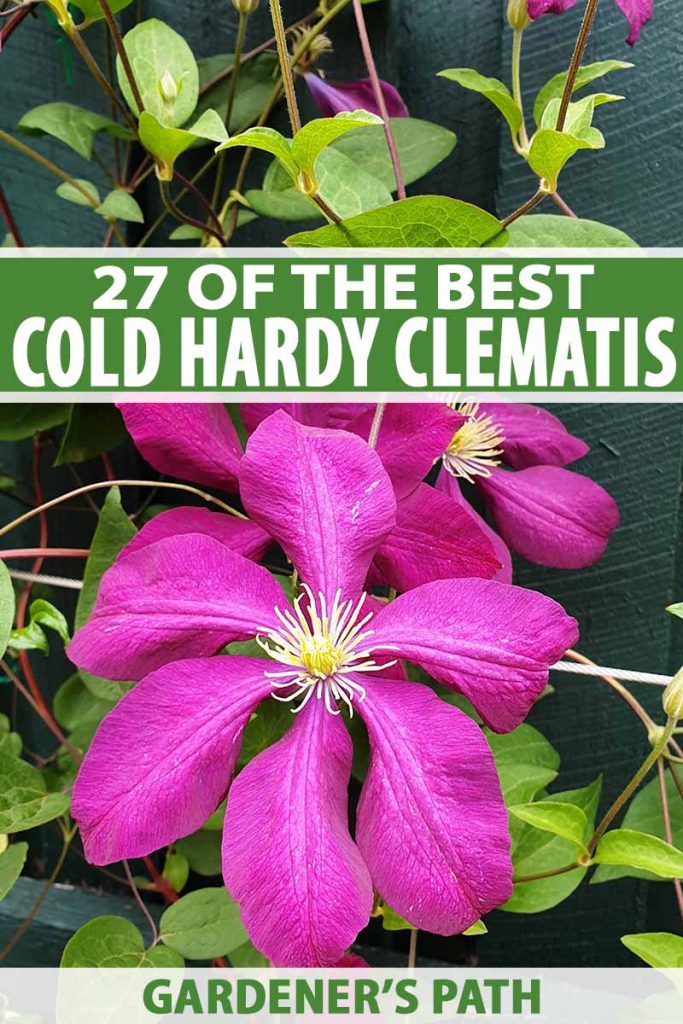
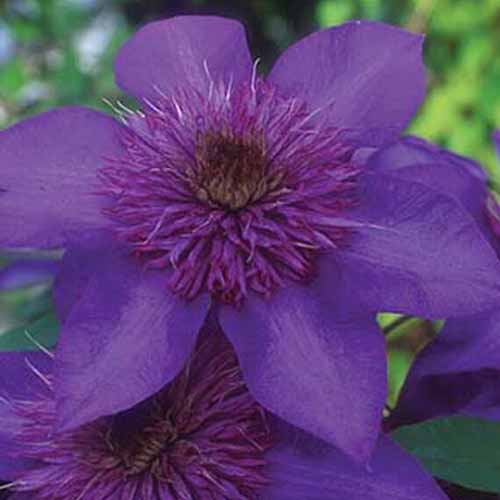
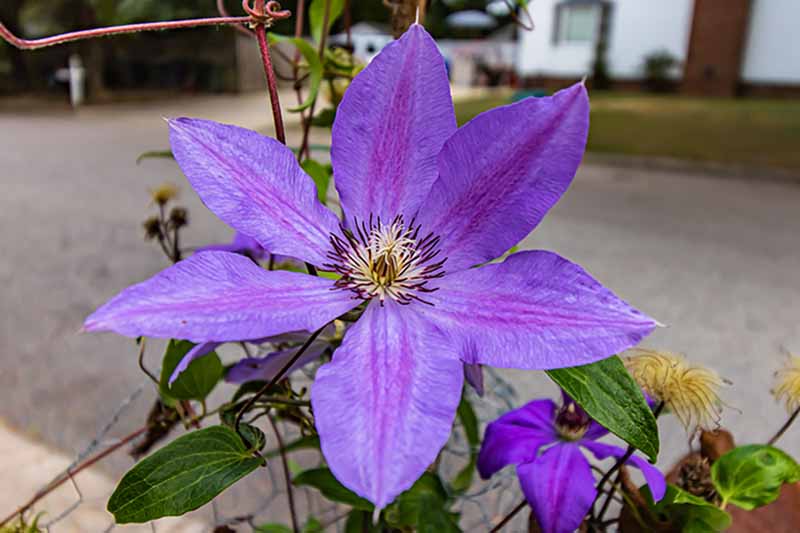
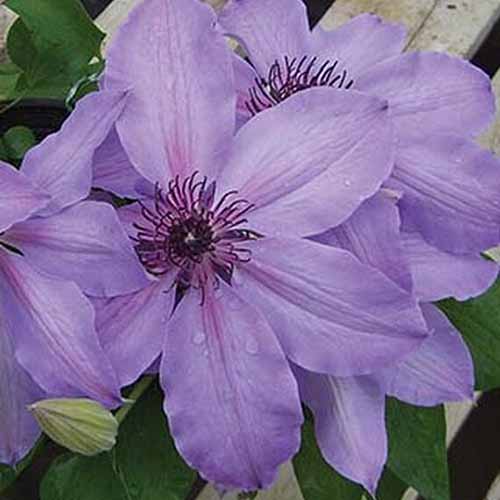
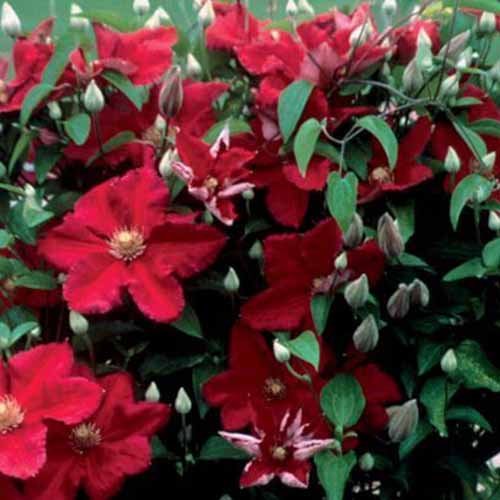
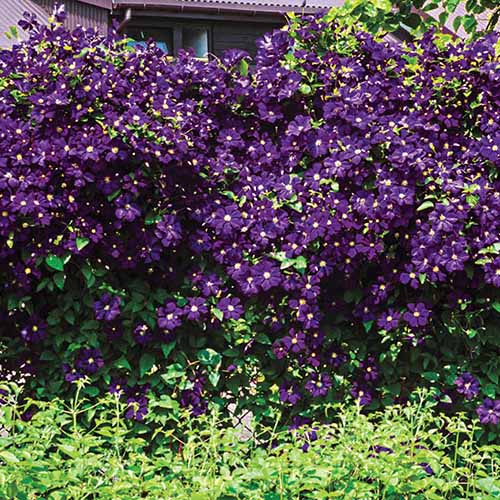
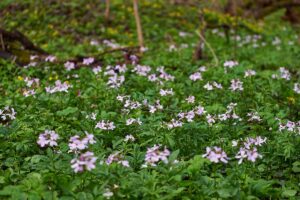
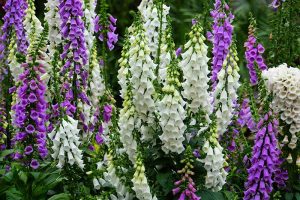
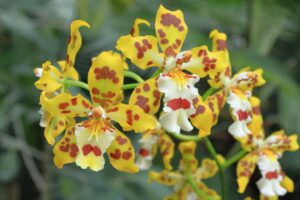
This article on clematis was really informative. I especially appreciated the explanation of the 3 groups. What’s the variety shown beneath the heading of the “The Big Chill”?
Hey Karen – unfortunately the photo used for that section didn’t list the particular species, but I suspect it’s two plants from the same group growing together. It’s hard to tell definitely without closer details, but the pale, shell pink flowers have dark red anthers, so I’m thinking a ‘Pink Fantasy’. And the prolific cherry colored one could easily be an ‘Ernest Markham’. Both are popular summer vines that bloom from midsummer to autumn and belong to the same pruning group (Group 3), making them easy to grow together for the pretty, two-tone effect. If those interest… Read more »
I have both Pink Fantasy and Margaret Hunt, and the vine growing with the Ernest markham is definitely Margaret Hunt. It does very well for me in my very harsh climate blooming profusely at least once and sometimes twice, getting all the way to the top of the house and growing along the gutters.
Ah, mystery solved! It looks like ‘Margaret Hunt’ is a prolific summer-into-fall bloomer and hardy into Zone 3 and 4 – a great choice for cold regions.
Thanks for the tip Louise, much appreciated!
Absolutely loved this informative article! We just planted an assortment of these from a local garden center for the new trellis wall at the end of our patio, having no idea they could be shorter or tolerate less sun than a gorgeous showy vine established on the south side of our new house. We will rely on this and the coming “summer” guide to supplement among the plants that survive. Many thanks!
When does the flower, the Big Chill bloom and how tall do they vine?
Hey Julie, please see my answer to Karen about the plants in the Big Chill photo – in the first comment above.
‘Pink Fantasy’ grows six to eight feet while ‘Ernest Markham’ has a mature height of 10 to 12 feet.
Thanks for asking!
Your title should say “COLD-HARDY CLEMATIS VARIETIES” with the hyphen.
You’re not describing “hardy clematis varieties” that are cold.
Rather, they’re cold-hardy clematis varieties.
Please help bring back word joinery and visual reading!
We have just moved into a new house…. an adult living compound. The garden space is small and we are trying to obtain maximum visual impact in the front NORTH facing garden. The house has 3 pillars: 2 on either side of the steps and one on the extreme right. We live in Toronto, Canada – zone 5b. Which clematis do you think would work best?
Hi Louella, sorry for the late reply… there are a few selections suitable for a shady north wall with Zone 5 winters.
Here are a few suggestions to get you started.
‘General Sikorski’
‘Helsingborg’
‘Markham’s Pink’
‘Niobe’
‘Pamela Jackman’
‘Wesselton’
Hope that helps!
Have you heard of a clematis called crown of thorns.
No I haven’t George, the only crown of thorns I know of is a euphorbia, E. millii.
Hi Lorna, Enjoyed this article, but I still can’t locate the plant I’m looking for. Please see the attached photo of a clematis that I would like to replace. I purchased it about 15 years ago at the Brooklyn Botanic Garden. I went away recently for a week during our drought and it fried in the heat. It’s not a “WOW-looking” variety, but it has a lovely way of growing up, over, and through other plants to add that little spark of purple. The flowers are about 2- 2 1/2 inches wide. lighter/ violet streaks down the length of the… Read more »
Hi Peter, thanks for the photo – the beautiful marbled petals make me think this is a cultivar called ‘Tie Dye’. It’s a sport, or mutation, of ‘Jacmanii’ and discovered at a New York nursery in 2001. But if you haven’t dug out the old plant yet, I recommend leaving it in place until next spring. Cut it back hard now, water regularly, and provide a winter mulch – often the roots survive when it looks as though the vines are dead and you might be pleasantly surprised with new shoots next year. If nothing appears by the end of… Read more »